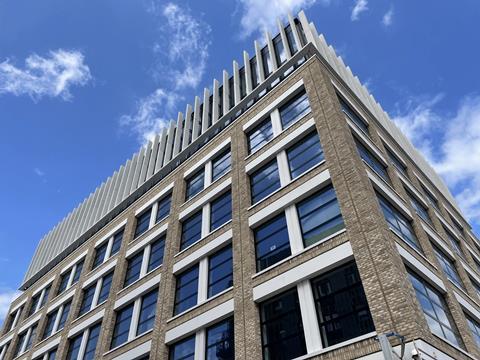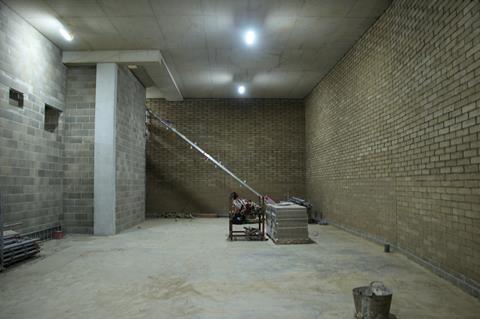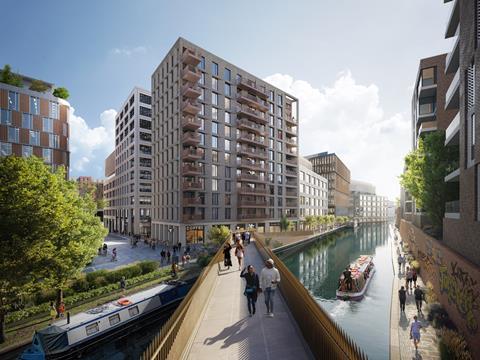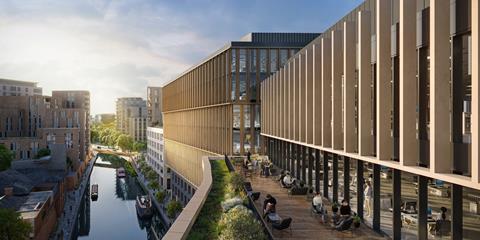London’s largest life sciences project is trialling the use of a low carbon earth brick for the basement walls of the first phase. It could be a game-changer for schemes looking to radically reduce their carbon footprint. Thomas Lane reports

Demand for life sciences laboratory space in London is seemingly insatiable. The Francis Crick Institute is converting its roof space into laboratories, insurer LV’s old office is being converted into labs and British Land is now offering lab space in its former, all-office Regent’s Place development.
So, it should come as a relief that the first phase of what will be London’s largest purpose-built life sciences facility is just completing. Called Tribeca, this was originally destined to be an office development until the Francis Crick Institute came along.

“We bought the site based on an office development and, while we were in planning, the Francis Crick opened,” explains Jason Russell, who is design director at Tribeca developer Reef Group. “This completely changed the area, so we started investigating demand for life sciences.
“We realised this was a great opportunity to be
the first to develop a purpose-built life sciences scheme in London.”
Tribeca includes four buildings, with the 112,340ft2 Apex first to complete. Apex will have BREEAM Excellent certification; Russell says the ambition is to achieve Outstanding on the rest of the scheme.
He adds that Apex is a test bed for the later buildings, which are just starting on site. This includes trialling an unfired earth brick to reduce upfront carbon emissions.
We have been exploring how we can move away from materials that are cemented or glued together, so they can’t be reused, to materials that can be reworked and used infinitely
Nikolay Shahpazov, project architect, Bennetts Associates
The brick has been used for the basement liner wall in place of concrete blocks. The walls are 5.9m high, with insulation and waterproofing layers behind it. The benefit is the carbon emissions from making the earth bricks are one- tenth of those from concrete block manufacture and, unlike the latter, could be regenerated to make new bricks.
“We must move away from building materials associated with resource depletion,” explains Nikolay Shahpazov, project architect at Bennetts Associates. “We have been exploring how we can move away from materials that are cemented or glued together, so they can’t be reused, to materials that can be reworked and used infinitely.”

The project investigated using the material excavated from the site to make the blocks. This has the twin benefit of reducing resource depletion and mitigating landfill taxes by reducing the amount of waste.
The team partnered with HG Matthews, a Buckinghamshire brickmaker that has pioneered low carbon forms of brick production. The clay subsoil from the Tribeca site contained more silt than that used for traditional brick manufacture but was good enough for making earth bricks.
HG Matthews tried three different mixes. The first was 100% Tribeca clay, the second included 25% sand and the third was a 50:50 mix. The mix includes some straw and water to make it sufficiently viscous to press into a mould.
Once moulded, the bricks are placed into an insulated drying room heated with a woodchip boiler to 50°C. After four to five days the bricks are dry and ready for use.
We were lucky that the subcontractor had a bunch of Moldovan block layers who all came from a region where earth blocks were very common. They found laying the bricks easy
Nikolay Shahpazov, project architect, Bennetts Associates
Shahpazov says tests revealed the 50:50 mix has a compressive strength of 6.5N/mm2, the 75:25 mix 4N/mm2 and the 100% subsoil brick 2.8N/mm2. He adds that the weakest brick could have been used for the basement walls but caution prevailed, with the team plumping for the strongest option.
The mortar is made from the same clay as the bricks. “We were lucky that the subcontractor had a bunch of Moldovan block layers who all came from a region where earth blocks were very common,” Shahpazov says. They found laying the bricks easy.
Russell says Reef Group was happy to try out the earth bricks, subject to some precautions. “We did all kinds of testing to make sure it was suitable.
“We used traditional blockwork for the first two courses in the walls where there is a risk of damp, and around service penetrations where there is risk of them getting wet.”
He describes the earth bricks as very successful, with Reef intending to use these for the second phase of the project. The bricks have since passed a fire test – this had the effect of firing the bricks – so will be used for internal basement walls too.
Shahpazov adds that there are potential other uses for earth bricks. They could be an alternative to concrete floor screeds or placed over CLT floor panels to add mass and reduce vibration.
The clay could be used as a plaster or have more straw so it could be used for insulation.
HG Matthews is currently testing panels for internal walls and also for compatibility with proprietary wind posts for extra structural stability. Russell says using earth bricks on Apex saved 10 tonnes of carbon, a figure that should increase as these are used more extensively on later phases.
Perhaps more importantly, the use of earth blocks on a commercial life sciences project like Tribeca will give other developers the confidence to use them too – which will have positive ramifications for construction’s carbon footprint.

The Tribeca development
Billed as London’s first purpose-built life sciences facility, Tribeca is located in London’s burgeoning knowledge quarter, which is centered on King’s Cross station. The scheme is sandwiched between St Pancras Way and the Regent’s Canal half a mile away from the Francis Crick Institute, which inspired the change from office use to a life sciences facility in 2018.
There will be four buildings with 600,000ft2 of laboratory and write-up space plus another 50,000ft2 of retail and leisure space when the scheme completes in 2026. Some of the lab space will be affordable and there will be events space and an auditorium too.
There is also a residential block on one corner of the scheme.

The first building, which is called Apex, is just now completing, with work under way on the remaining three buildings which are called Reflector, Assembly and the Connector. Described as a test bed for the later buildings, the seven-storey Apex features a reinforced concrete frame with post-tensioned slabs to maximise floor-to-ceiling heights.
The building features large, warehouse-style punched windows and is clad with brick to emphasise the warehouse aesthetic. It steps back above the fifth floor, with the cladding switching to precast vertical fins to soften the mass of the building and provide a roof terrace overlooking the canal.

Improving the public realm is also a key part
of the project. The site was previously home to a sorting office known as the “ugly brown building”, which blocked public access from St Pancras Way to the canal.
The development will be much more permeable and include a new bridge across the canal to
link the scheme to the King’s Cross Central development including Coal Drops Yard.
The London BioScience Innovation Centre, which is part of the Royal Veterinary College nearby, has taken part of the basement and the ground, first and second floors of Apex and has started fitting out its floors with completion expected towards the end of the year.
The Francis Crick Institute has partnered with Reef Group to provide space on the remaining floors to more commercially focused AI and biotech companies.
Project team
Developer Reef Group
Architect for Apex Bennetts Associates
Architect for Reflector, Assembly and the Connector Perkins & Will
Structural engineer GD Partnership
MEP engineer KJ Tait
Facade engineer Patrick Ryan Associates
Cost and project management Gardiner & Theobald
Planning consultant DP9
Landscape Architects Camlins
Contractor for Apex VolkerFitzpatrick
Contractor for Reflector, Assembly and the Connector Ardmore



























1 Readers' comment